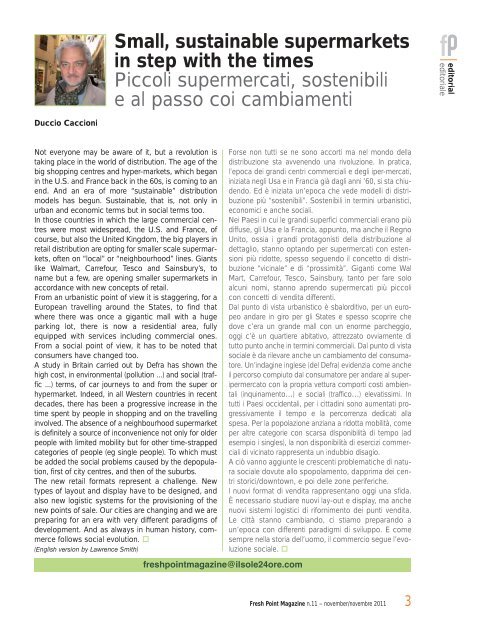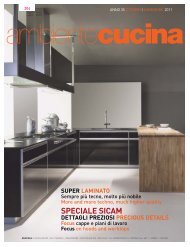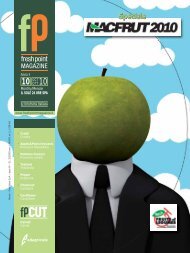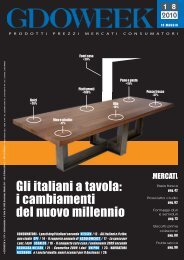Fresh Point Magazine - B2B24 - Il Sole 24 Ore
Fresh Point Magazine - B2B24 - Il Sole 24 Ore
Fresh Point Magazine - B2B24 - Il Sole 24 Ore
You also want an ePaper? Increase the reach of your titles
YUMPU automatically turns print PDFs into web optimized ePapers that Google loves.
Duccio Caccioni<br />
Small, sustainable supermarkets<br />
in step with the times<br />
Piccoli supermercati, sostenibili<br />
e al passo coi cambiamenti<br />
Not everyone may be aware of it, but a revolution is<br />
taking place in the world of distribution. The age of the<br />
big shopping centres and hyper-markets, which began<br />
in the U.S. and France back in the 60s, is coming to an<br />
end. And an era of more “sustainable” distribution<br />
models has begun. Sustainable, that is, not only in<br />
urban and economic terms but in social terms too.<br />
In those countries in which the large commercial centres<br />
were most widespread, the U.S. and France, of<br />
course, but also the United Kingdom, the big players in<br />
retail distribution are opting for smaller scale supermarkets,<br />
often on “local” or “neighbourhood” lines. Giants<br />
like Walmart, Carrefour, Tesco and Sainsbury’s, to<br />
name but a few, are opening smaller supermarkets in<br />
accordance with new concepts of retail.<br />
From an urbanistic point of view it is staggering, for a<br />
European travelling around the States, to find that<br />
where there was once a gigantic mall with a huge<br />
parking lot, there is now a residential area, fully<br />
equipped with services including commercial ones.<br />
From a social point of view, it has to be noted that<br />
consumers have changed too.<br />
A study in Britain carried out by Defra has shown the<br />
high cost, in environmental (pollution ...) and social (traffic<br />
...) terms, of car journeys to and from the super or<br />
hypermarket. Indeed, in all Western countries in recent<br />
decades, there has been a progressive increase in the<br />
time spent by people in shopping and on the travelling<br />
involved. The absence of a neighbourhood supermarket<br />
is definitely a source of inconvenience not only for older<br />
people with limited mobility but for other time-strapped<br />
categories of people (eg single people). To which must<br />
be added the social problems caused by the depopulation,<br />
first of city centres, and then of the suburbs.<br />
The new retail formats represent a challenge. New<br />
types of layout and display have to be designed, and<br />
also new logistic systems for the provisioning of the<br />
new points of sale. Our cities are changing and we are<br />
preparing for an era with very different paradigms of<br />
development. And as always in human history, commerce<br />
follows social evolution.<br />
(English version by Lawrence Smith)<br />
freshpointmagazine@ilsole<strong>24</strong>ore.com<br />
Forse non tutti se ne sono accorti ma nel mondo della<br />
distribuzione sta avvenendo una rivoluzione. In pratica,<br />
l’epoca dei grandi centri commerciali e degli iper-mercati,<br />
iniziata negli Usa e in Francia già dagli anni ’60, si sta chiudendo.<br />
Ed è iniziata un’epoca che vede modelli di distribuzione<br />
più “sostenibili”. Sostenibili in termini urbanistici,<br />
economici e anche sociali.<br />
Nei Paesi in cui le grandi superfici commerciali erano più<br />
diffuse, gli Usa e la Francia, appunto, ma anche il Regno<br />
Unito, ossia i grandi protagonisti della distribuzione al<br />
dettaglio, stanno optando per supermercati con estensioni<br />
più ridotte, spesso seguendo il concetto di distribuzione<br />
“vicinale” e di “prossimità”. Giganti come Wal<br />
Mart, Carrefour, Tesco, Sainsbury, tanto per fare solo<br />
alcuni nomi, stanno aprendo supermercati più piccoli<br />
con concetti di vendita differenti.<br />
Dal punto di vista urbanistico è sbalorditivo, per un europeo<br />
andare in giro per gli States e spesso scoprire che<br />
dove c’era un grande mall con un enorme parcheggio,<br />
oggi c’è un quartiere abitativo, attrezzato ovviamente di<br />
tutto punto anche in termini commerciali. Dal punto di vista<br />
sociale è da rilevare anche un cambiamento del consumatore.<br />
Un’indagine inglese (del Defra) evidenzia come anche<br />
il percorso compiuto dal consumatore per andare al superipermercato<br />
con la propria vettura comporti costi ambientali<br />
(inquinamento…) e sociali (traffico…) elevatissimi. In<br />
tutti i Paesi occidentali, per i cittadini sono aumentati progressivamente<br />
il tempo e la percorrenza dedicati alla<br />
spesa. Per la popolazione anziana a ridotta mobilità, come<br />
per altre categorie con scarsa disponibilità di tempo (ad<br />
esempio i singles), la non disponibilità di esercizi commerciali<br />
di vicinato rappresenta un indubbio disagio.<br />
A ciò vanno aggiunte le crescenti problematiche di natura<br />
sociale dovute allo spopolamento, dapprima dei centri<br />
storici/downtown, e poi delle zone periferiche.<br />
I nuovi format di vendita rappresentano oggi una sfida.<br />
È necessario studiare nuovi lay-out e display, ma anche<br />
nuovi sistemi logistici di rifornimento dei punti vendita.<br />
Le città stanno cambiando, ci stiamo preparando a<br />
un’epoca con differenti paradigmi di sviluppo. E come<br />
sempre nella storia dell’uomo, il commercio segue l’evoluzione<br />
sociale.<br />
<strong>Fresh</strong> <strong>Point</strong> <strong>Magazine</strong> n.11 – november/novembre 2011<br />
3<br />
editorial<br />
editoriale
















